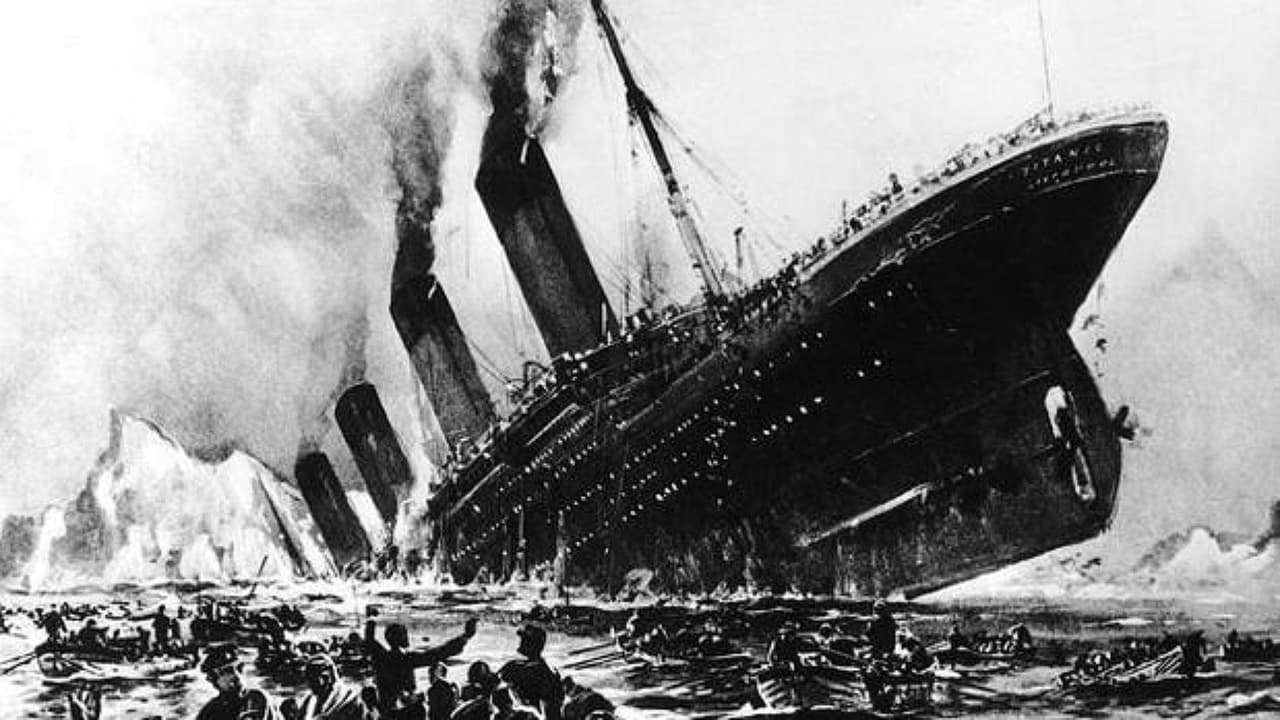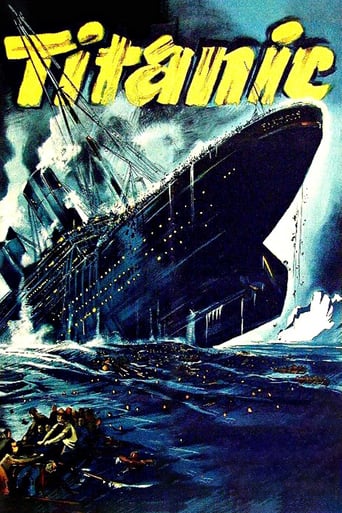

Am I Missing Something?
... View MoreEntertaining from beginning to end, it maintains the spirit of the franchise while establishing it's own seal with a fun cast
... View MoreThe film may be flawed, but its message is not.
... View MoreA film of deceptively outspoken contemporary relevance, this is cinema at its most alert, alarming and alive.
... View MoreThe Teutonic TITANIC's been called everything from "artistically terrible" to "morbidly compelling" and with good reason. It's also talky (or, in this case, subtitle-y) and doesn't really kick in until the final minutes but considering the anti-British agenda, the doomed ship was merely a medium for the message anyway. Not only is the film of historical importance as a pluperfect example of Nazi agitprop, the backstory's as tragic as the events unfolding on screen:Third Reich Propaganda Minister Josef Goebbels heartily endorsed the project because he thought the tragic tale was "a classic case of British incompetency" but, ironically, after its completion he banned the film in Germany, thinking the scenes of panic and despair hit too close to home for a beleaguered populace in a time of heavy Allied bombing. The director, Herbert Selpin, was overheard making a crack about the German navy and promptly hauled off by the Gestapo who put him in prison; he was later found hanging in his cell, a "suicide", of course. Troubled star Sybille Schmitz was also the real-life inspiration for Rainer Warner Fassbinder's VERONIKA VOSS but the darkest of all fates awaited the S.S. Cap Arcona, a one-time luxury liner used in the filming. In May, 1945, the Cap Arcona, commandeered by the German navy, was ferrying prisoners of war in the Baltic when it was sunk by the RAF. "Pilots of the attacking force stated that they were unaware that the ships were laden with prisoners who had survived the camps... The RAF commanders ordering the strike reportedly thought that the ships carried escaping SS officers." More than 5,000 lost their lives that night (five times Titanic's death toll and the second worst maritime disaster in history) and it's said that survivors in the water were picked off by Nazi snipers as they tried to swim ashore. As late as 1971, skulls and bones were still washing up on beaches. After WWII, TITANIC was considered one of the "spoils of war" and American and British filmmakers were free to use footage from it whenever they wanted. Snippets show up in 1958's A NIGHT TO REMEMBER as well as a slew of U.S. television shows in the 50s & 60s. The panic, terror, and grisly particulars of the sinking of the Cap Arcona are as dramatic as any Titanic re-telling:"Equipped with lifejackets from locked storage compartments, most of the SS guards were able to jump overboard from the Cap Arcona, and there appear to be rumors that despite the water temperature of only 7°C, they were busy shooting any prisoners who tried to escape. German trawlers sent to rescue Cap Arcona's crew members and guards managed to save 16 sailors, 400 SS men, and 20 SS women. Most of the prisoners who tried to board the trawlers were beaten back, while those who reached shore were shot down. The prisoners that managed to swim ashore were mainly gunned by the SS. Only 350 of the 4,500 former concentration camp inmates who had been aboard the Cap Arcona survived. RAF Pilot Allan Wyse of No. 193 Squadron later recalled, "We used our cannon fire at the chaps in the water . . . we shot them up with 20mm cannons in the water. Horrible thing, but we were told to do it and we did it. That's war." Severely damaged and set on fire, the Cap Arcona eventually capsized. The death toll was estimated at 5,000 people."One last thing about the Cap Arcona catastrophe -quite a few of those concentration camp survivors were captured American soldiers which makes this the most horrific case of "friendly fire" ever.
... View MoreA movie of the Titanic tragedy that is even worse than James Cameron's billion dollar turd. Who'da thunk it? At least this one comes in at under 90 minutes (probably thanks to Joseph Goebbels, who objected to the scenes of panic and destruction in the middle of the war). Yes, this is a film made in Nazi Germany when the film industry was under the command of Joseph Goebbels. And, yes, as you might expect it's pretty much a propaganda film. That aspect of it does provide some interest. The protagonist of the film is Hans Nielsen, a fictional (I assume) German first officer who insists to the head of the White Star Line company that the Titanic is not ready, as well as reminding him and his captain that they are moving too fast through iceberg-infested waters. If only the idiotic, slimy, capitalist Brits would listen to Hans! At least the Germans were avenging Hans' humiliation by bombing the bejesus out of England at the time the movie opened. Unfortunately, what little interest is provided by the propaganda element isn't enough to make the turgid melodrama worth sitting through. Not unlike Cameron's Titanic, romance abounds on the doomed ocean liner, including one between Hans and actress Sybille Schmitz. I knew Schmitz's name from the fact that Rainer Werner Fassbinder based the character of Veronika Voss on her. Schmitz doesn't look like Voss, though, and it took me a long while to figure out why she looked so much like some kind of ghoul. Ah! I did know here from somewhere: she co-starred in Carl Dreyer's Vampyr as the young woman who is possibly becoming a vampire. There are a couple of other romances, too, one between two workers on the ship and also a flirtation between some peasants on the lower deck. The film really doesn't care about any of these people, though. Most of the "action" in the film, like at least the first half, is taken up by long discussions of how much money various passengers have and what their social status might be. When the ship finally starts to sink, it improves slightly, but, since it's all but unwatchable up to that point, I just wanted it to end.
... View MoreTitanic (1943) *** (out of 4) Very interesting and highly entertaining version of the disaster told through the eyes of a German director and cast. This is certainly a war propaganda film and the closing line takes a direct hit at the British but even with all of that the film still manages to entertain. It's clear the German's wanted Americans and the British to look like idiots but why on Earth would they keep the cast speaking German? Who knows. The one good guy in the film, a German officer, is the hero here. Even stranger is that the film was originally banned in Germany and wasn't shown there for over six years. Interestingly, director Herbert Selpin was arrested by the Gestapo during filming and the next day was found dead in his cell. Some say he was murdered but the Gestapo claimed suicide.
... View MoreSlowly some of the Nazi film industry's work product is becoming available by video and by DVD. Not everything (except if you deal with extreme - right wing groups) but some of their material. TITANIC is one of the few acceptable films.I think the reason it is acceptable is that we are aware of social inequalities in the disaster that were not officially noted in 1912. The treatment of steerage passengers for example (more first and second class men survived than third class women). The misappropriation of an entire lifeboat by Sir Cosmo and Lady Duff Gordon and their small party was another. So was the survival of the President of the White Star Line, J. Bruce Ismay (not Sir Bruce Ismay - he was never knighted before 1912, and he was a social pariah after 1912). But that's just it - Ismay and the Duff Gordons were socially ruined by their survival and the attending circumstances. The British Inquiry of Lord Mersey was not too harsh on them, but the American Inquiry of Senator William Alden Smith certainly was. Ismay was all too happy to leave New York City after Smith got through with him.So, yes, the story is truthfully full of social unfairness and bigotry and selfishness. But there is also heroism and self sacrifice, and the Goebbels' "Ministry of Information and Propaganda" overlooked that part. Molly Brown, Isidor and Ida Strauss, Benjamin Guggenheim, Thomas Andrews, Lightoller, Philips and Bride, are not mentioned - why should they be. Goebbels wanted to use the disaster as a weapon to poison German and Axis audiences against Britain, America, and Jews. Why honor Americans like Brown, Britains like Andrews, Lightoller, Philips and Bride, and Jews like the Strausses and Guggenheim? So he jettisoned them.From a technical standpoint TITANIC was an amazing film for 1943 - in fact the British film A NIGHT TO REMEMBER supposedly used some of the scenes of the sinking liner from TITANIC. But the propaganda is always there.Curiously, the British and Americans did not think of using the war to make a film called LUSITANIA. It might have been a sufficiently more honest answer to Goebbels lies and half-truths. The closest I have seen to that (aside from brief mentions of the Lusitania in FOR ME AND MY GAL, 'TIL THE CLOUDS ROLL BY, and NIGHT AND DAY) was a sequence in the Mitchel Leisin film ARISE MY LOVE about the sinking of the steamer Athenia in September 1939 (when it was sunk by a U-boat without warning - Goebbels and Hitler caused an information freeze on that incident). Now, perhaps, we can do films about the Lancastria disaster (bombing and strafing fleeing refugees from Dunkirk with glee - and costing 3,000 - 4,000 lives) or the Cap Ancona massacre of concentration camp victims (about 6,000 lives or more). They show, in my opinion, the selfishness, greed, and class distinctions practiced by Nazis.
... View More